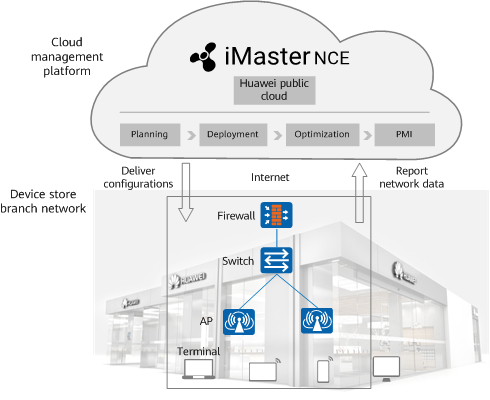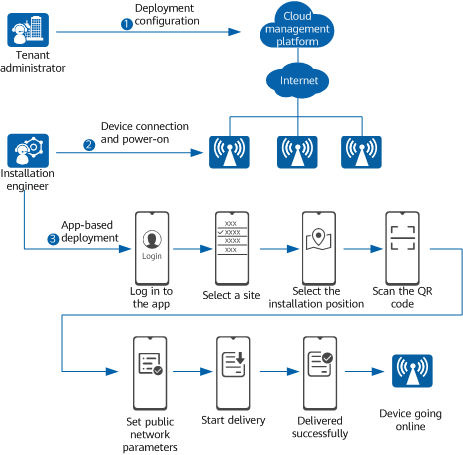What Is Cloud Managed Network
A cloud managed network is a network that is managed from the cloud. It represents an innovative network management mode that utilizes the cloud management platform to manage and monitor network devices and service experience based on emerging technologies such as big data, artificial intelligence, and cloud computing. Huawei Cloud Managed Network Solution is implemented based on the CloudCampus cloud management platform on the Huawei public cloud. With this solution, cloud managed devices such as APs, switches, routers, and firewalls are managed on the cloud, allowing for fast deployment and centralized management of networks for Small and Medium-Sized Businesses (SMBs) and multi-branch organizations. The entire lifecycle of the network can be managed on the cloud, encompassing procurement, planning, provisioning, deployment, maintenance, and operation phases.
What Is Cloud Managed Network?
The Cloud Managed Network Solution uses a cloud management platform on the Huawei public cloud to manage network devices such as APs, switches, routers, and firewalls from the cloud. In this way, it is easy to quickly deploy and centrally manage networks for SMBs and multi-branch organizations. The Huawei solution provides one-stop managed services throughout the network lifecycle, from procurement, planning, provisioning, and deployment to O&M and operation — all from the cloud. In addition, the solution innovatively divides a campus network into three layers: multi-tenant network, cloud management platform, and value-added SaaS platform.

Architecture of the cloud managed network
- Multi-tenant network: consists of hundreds of network devices, including APs, switches, firewalls, and ARs, and is deployed at the customer side to provide user access.
- Cloud management platform: core component of the Cloud Managed Network Solution and is a cloud-based network management, O&M, and control system. In addition to basic management and configuration for cloud managed devices, remote O&M and monitoring, and user access control, the cloud management platform can implement various VASs based on the big data platform. iMaster NCE-CampusInsight is an intelligent network analysis engine that provides intelligent O&M services for user networks by applying artificial intelligence to the O&M domain. Based on data such as device performance indicators and terminal logs, iMaster NCE-CampusInsight digitizes user experience on the network through big data analytics, artificial intelligence algorithms, and more advanced analysis technologies, enabling customers to quickly detect network problems promptly and improve user experience.
- Value-added SaaS platform: The cloud management platform provides open APIs for interoperation with other service systems (such as the big data platform) to offer tenants a variety of value-added application services, such as customer flow analysis, business portal page push, electronic shelf label (ESL), asset management, and medical IoT.
When designing the architecture of the Huawei Cloud Managed Network Solution, construct a cloud campus communication network that features unified bearing, on-demand definition, and elastic scaling. Next, determine the networking scheme of the multi-tenant network based on user requirements and application scenarios, and conduct the network design according to the actual service requirements of users, including the physical network design, basic network service, WLAN service, and user access control design. After the network design is complete, use a centralized cloud management system to implement automatic management and intelligent analysis of the network with automated deployment and intelligent O&M features. In addition, to meet the requirements of such basic network attributes as security, reliability, and openness, design relating to network security and interconnection with other value-added platforms must also be considered. Through this three-layer architecture-based approach, Huawei and partners can provide enterprises with simplified, smart, and super-fast campus network solutions.
Why Cloud-based Network Management?
As digital transformation accelerates across various industries, enterprise services are becoming more diversified than ever, which in turn poses all-new requirements on networks. For example, chain stores need to quickly deploy networks, roll out services, and respond to faults, while shopping malls and supermarkets aim to provide customers with free Wi-Fi as well as store and parking navigation services using wireless positioning technologies. The implementation of precision marketing through customer flow data analysis is another key requirement.
Generally speaking, enterprise digital transformation focuses on two purposes. The first relates to internally improving efficiency and reducing costs, and the other involves externally enhancing service experience and customer satisfaction. Can traditional networks meet these two expectations?
The answer is no. Traditional networks face many issues relating to network deployment, management, and O&M. First, network deployment is inefficient. Specifically, new service provisioning is slow, and highly skilled IT personnel are required for onsite configuration, commissioning, and acceptance. Second, network management is complex, resulting in high OPEX, and enterprises are required to establish professional network O&M teams. Third, networks are not open enough and lack standards-compliant interfaces, making multi-vendor interconnection difficult.
In short, digital transformation introduces changes to the network model, while the traditional network management mode can no longer meet the new requirements of digital services. In particular, with the migration of services onto the cloud, networks must keep pace in order to transform from the traditional asset-heavy model to the asset-light cloud service model.
For example, a company in the healthcare industry is dedicated to building a new healthcare service platform by combining the Internet with healthcare. As an Internet-enabled startup, it was tasked with digitally transforming more than 200 hospitals and over 500,000 beds across the country during its rapid market presence expansion. To this end, the company sought out an innovative network architecture capable of meeting its specific needs. For example, networks needed to be rapidly deployed; nationwide networks must be centrally managed, easy to expand, and easy to maintain; and big data and other value-added services should be provided based on networks.
If using a more traditional approach, it would have to spend an average of 10 person-days to deploy the network for each hospital, requiring a five-employee O&M team for each city. Instead, Huawei's Cloud Managed Network Solution enables network deployment for each hospital in just 3 person-days, with only two O&M employees needed in each city. This reduces initial investment by 45%, cuts O&M expenditure by 83%, and accelerates service rollout by 300%. In this way, Huawei's solution allows the company to focus more on quickly seizing the market and reaching its original goal of digital transformation.
What Are the Differences Between a Cloud Managed Network and a Traditional Network?
Huawei's Cloud Managed Network Solution uses a series of advanced technologies to remotely and centrally manage network devices. For example,
- In terms of network management protocols, Huawei's solution uses NETCONF and YANG, instead of the traditional SNMP.
- Unlike traditional networks that use SNMP for network monitoring, Huawei's solution uses Telemetry and HTTP/2, instead.
- With regards to network configuration methods, traditional networks rely heavily on CLIs, whereas Huawei's solution provides more visually intuitive GUIs. It also allows customized configuration tools through APIs.
- In Huawei's solution, the cloud management platform provides standard RESTful APIs to facilitate the rapid development of numerous value-added services. Currently, the cloud management platform supports more than 180 types of applications across various industries such as retail, hospitality, education, and healthcare, helping industry players to expand SaaS value-added services.
For details about key technologies or protocols such as NETCONF, YANG, Telemetry, and RESTful, see our new book Campus Network Architectures and Technologies.
How Does the Cloud Managed Network Work?
The following uses a Huawei store as an example to showcase how Huawei's Cloud Managed Network Solution redefines network planning, deployment, and O&M. With the rapid development of its device business, Huawei opens an average of 300 new stores every year on average. To facilitate such rapid expansion, the company uses its Cloud Managed Network Solution to quickly deploy networks. To elaborate further, network administrators can use a mobile app to scan equipment serial numbers (ESNs) for rapid deployment, which greatly accelerates network deployment at Huawei stores and enabling the entire process to be completed within a single day.

Example: Huawei device stores use the Cloud Managed Network Solution to quickly deploy networks
To begin, the tenant administrator imports the ESNs of network devices (for example, APs) in batches into the cloud management platform and plans service configurations online. Then, installation engineers connect and power on the APs at device stores, log in to the CloudCampus APP, use the barcode scanning function to establish links between the APs and the cloud management platform, and deliver public network configurations to the APs through the local management SSID. This ensures that the APs can be discovered, deployed, and managed by the cloud management platform. After the APs are deployed, they stay connected to the cloud management platform and periodically report their performance data to it. In this way, the administrator can easily perform routine maintenance, periodic inspection, troubleshooting, and other tasks through the cloud management platform.

Barcode-scanning deployment using a mobile app
- Author: Huang Mingxiang
- Updated on: 2021-09-30
- Views: 8200
- Average rating:







